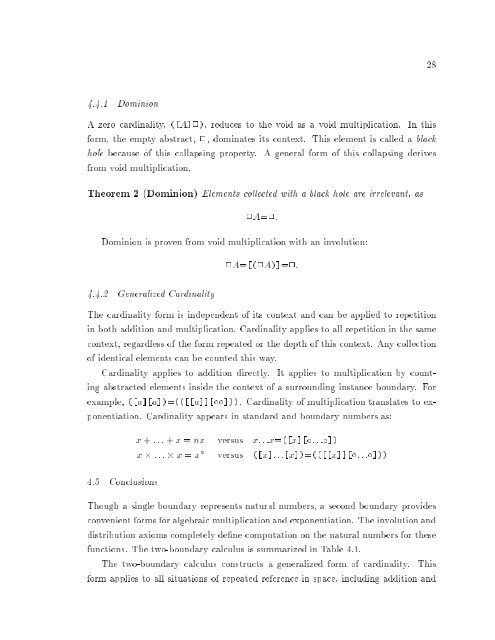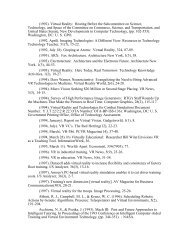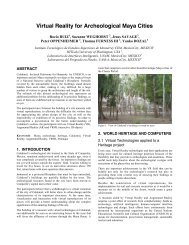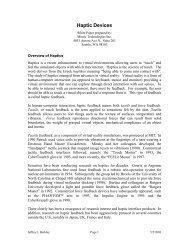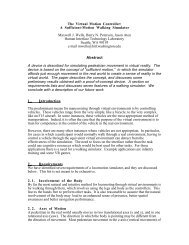A Calculus of Number Based on Spatial Forms - University of ...
A Calculus of Number Based on Spatial Forms - University of ...
A Calculus of Number Based on Spatial Forms - University of ...
You also want an ePaper? Increase the reach of your titles
YUMPU automatically turns print PDFs into web optimized ePapers that Google loves.
28<br />
4.4.1 Domini<strong>on</strong><br />
A zero cardinality, ([A]2), reduces to the void as a void multiplicati<strong>on</strong>. In this<br />
form, the empty abstract, 2, dominates its c<strong>on</strong>text. This element is called a black<br />
hole because <str<strong>on</strong>g>of</str<strong>on</strong>g> this collapsing property. A general form <str<strong>on</strong>g>of</str<strong>on</strong>g> this collapsing derives<br />
from void multiplicati<strong>on</strong>.<br />
Theorem 2 (Domini<strong>on</strong>) Elements collected with a black hole are irrelevant, as<br />
2A=2:<br />
Domini<strong>on</strong> is proven from void multiplicati<strong>on</strong> with an involuti<strong>on</strong>:<br />
2A=[(2A)]=2:<br />
4.4.2 Generalized Cardinality<br />
The cardinality form is independent <str<strong>on</strong>g>of</str<strong>on</strong>g> its c<strong>on</strong>text and can be applied to repetiti<strong>on</strong><br />
in both additi<strong>on</strong> and multiplicati<strong>on</strong>. Cardinality applies to all repetiti<strong>on</strong> in the same<br />
c<strong>on</strong>text, regardless <str<strong>on</strong>g>of</str<strong>on</strong>g> the form repeated or the depth <str<strong>on</strong>g>of</str<strong>on</strong>g> this c<strong>on</strong>text. Any collecti<strong>on</strong><br />
<str<strong>on</strong>g>of</str<strong>on</strong>g> identical elements can be counted this way.<br />
Cardinality applies to additi<strong>on</strong> directly. It applies to multiplicati<strong>on</strong> by counting<br />
abstracted elements inside the c<strong>on</strong>text <str<strong>on</strong>g>of</str<strong>on</strong>g> a surrounding instance boundary. For<br />
example, ([a][a])=(([[a]][])). Cardinality <str<strong>on</strong>g>of</str<strong>on</strong>g>multiplicati<strong>on</strong> translates to exp<strong>on</strong>entiati<strong>on</strong>.<br />
Cardinality appears in standard and boundary numbers as:<br />
x + :::+x= nx versus x:::x=([x][:::])<br />
x :::x= x n versus ([x]:::[x])=(([[x]][:::]))<br />
4.5 C<strong>on</strong>clusi<strong>on</strong>s<br />
Though a single boundary represents natural numbers, a sec<strong>on</strong>d boundary provides<br />
c<strong>on</strong>venient forms for algebraic multiplicati<strong>on</strong> and exp<strong>on</strong>entiati<strong>on</strong>. The involuti<strong>on</strong> and<br />
distributi<strong>on</strong> axioms completely dene computati<strong>on</strong> <strong>on</strong> the natural numbers for these<br />
functi<strong>on</strong>s. The two-boundary calculus is summarized in Table 4.1.<br />
The two-boundary calculus c<strong>on</strong>structs a generalized form <str<strong>on</strong>g>of</str<strong>on</strong>g> cardinality. This<br />
form applies to all situati<strong>on</strong>s <str<strong>on</strong>g>of</str<strong>on</strong>g> repeated reference in space, including additi<strong>on</strong> and


